|
|
 |
|
Calanoida ( Order ) |
|
|
|
Clausocalanoidea ( Superfamily ) |
|
|
|
Euchaetidae ( Family ) |
|
|
|
Paraeuchaeta ( Genus ) |
|
|
| |
Paraeuchaeta tycodesma (Park, 1978) (F,M) | |
| | | | | | | Syn.: | Euchaeta antarctica Giesbrecht, 1902 (p.22, figs.M);
Euchaeta tycodesma Park, 1978 (p.229, Descr.F, figs.F); Fontaine, 1988 (p.45, figs.F,M) | | | | Ref.: | | | Bradford, 1981 (p.391, 401, figs.M); Bradford & al., 1983 (p.25); Park, 1994 (p.321); 1995 (p.91, Rem.) | 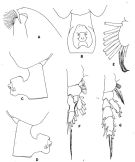 issued from : T. Park in Antarctic Res. Ser. Washington, 1978, 27. [p.230, Fig.83]. As Euchaeta tycodesmaFemale: A, forehead (lateral); B, C, D, distal end of metasome and genital segment (ventral, left side, right side, respectively); E, outer lobe of Mx1; F, P1; G, P2. P1-2: legs (anterior).
|
 issued from : J.M. Bradford in N.Z. Jl Mar. Freshw. Res., 1981, 15 (4). [p.399, Fig.8]. male: (from McMurdo Sound): A, P5 (clasping a spermatophore); B, terminal part of left exopod of P5; C, serrated lamella; D, exopod of P1; E, terminal part of exopod of P2.
|
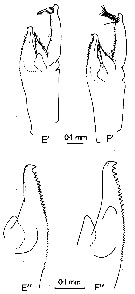 issued from : J.M. Bradford in N. Z. Jl Mar. Freshw. Res., 1981, 15. [p.395, Fig.4, E', F', E\", F\"] . Male: e', F', terminal part of P5; E\", F\", serrated lamella. Nota: The serrated lamella is shaped rather like that of P. erebi but is shorter relative to the 3rd exopodal segment, being 3/5 its length
|
 issued from : J.M. Bradford in N. Z. Jl Mar. Freshw. Res., 1981, 15. [p.401, Table 5 (part.)]. Female & Male (from Giesbrecht, 1902): Distinguishing features of species of Paraeuchaeta closely related to P. antarctica (* for code see p.393, Fig.2 in P. erebi).
|
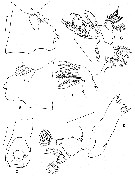 issued from M. Fontaine in Biol. Antarctic Seas XIX, Antact. Res. Ser., 1988, 47. [p.44, Fig.14]. As Euchaeta tycodesma. Female (from Ross Sea): A-C, genital segment (right lateral, left lateral, and ventral, respectively); D, Md (gnathobase); E, Md (mandibular palp); F-G, Mx1. Scale bars: 0.5 mm each. Nota: Mxp without ''flagellum'' or tiny spinules on the tips of the strong setae of the endopod.
|
 issued from M. Fontaine in Biol. Antarctic Seas XIX, Antact. Res. Ser., 1988, 47. [p.45, Fig.15]. As Euchaeta tycodesma. Female: A, P1; B, P2. Nota: Relative lengths of outer edge spines and setae (code see in P. antractica). Exopod of P1: Aa AB; Bb ± 5/4 BC; Cc = 4/3 BC. Exopod of P2: Aa ± 3/2 AB; Bb ± 1/2 BC; Cc < CD. male: distal end of left P5 (medial).
|
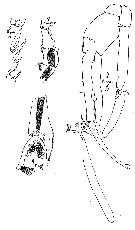 issued from : W. Giesbrecht in Copepoden. Res. voyage du S. Y. Belgica. Rapports scientifiques, Zoologie, 1902. [Taf. III, Figs. 4, 6-8]. As Euchaeta antarctica. Male (from S Peter Ist Island, Bellingshausen Sea): 4, P1; 6, exopodite 3 of P2; 7, P5 with spermatophore (anterior); 8, distal part of left P5. Nota: For Bradford (1981, p.401) this male assigned to P. antarctica by Giesbrecht (1902) and P. tycodesma are undoutedly conspecific in view of the size and shape of the serrated lamella and the size of the spermatophore held in the P5.
|
 Paraeuchaeta tycodesma Female: 1 - See key to species Groups and independent species of Paraeuchaeta (p.30). 2 - None of endopodal setae of Mx2 armed with long spinules in addition to usual spinules. 3 - Genital segment without transverse ridge on ventral side anterior to genital prominence. 4 - Ventrally, genital field more or less symmetrical (Fig.83 B in Park, 1978).
| | | | | Compl. Ref.: | | | Razouls & al., 2000 (p.343, tab. 2, 5, Appendix); Park & Ferrari, 2009 (p.143, Table 3, 8, Appendix 1, biogeography) | | | | NZ: | 1 | | |
|
Distribution map of Paraeuchaeta tycodesma by geographical zones
|
| | | | | | 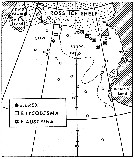 issued from M. Fontaine in Biol. Antarctic Seas XIX, Antact. Res. Ser., 1988, 47. [p.43, Fig.13]. issued from M. Fontaine in Biol. Antarctic Seas XIX, Antact. Res. Ser., 1988, 47. [p.43, Fig.13].
Occurrence of P. tycodesma.
Open circles show stations where no adults were found. RSSW = Ross Sea Shelf Water; CDW = Circumpolar Deep Water.
Nota: For Fontaine (1988, p.46) P. tycodesma is restricted to the Ross Sea in its distribution Although in this material P. tycodesma was collected only in the southeastern part of the Ross Sea, north of Ross Island, Park’s specimens were collected well out in the middle of the Ross Sea, probably in Circumpolar Deep Water. The male was described by Bradford (1981) from material collected from under the ice in McMurdo Sound. |
| | | | Loc: | | | Antarct. (SW Pacif., Ross Sea, McMurdo Sound, Bellingshausen Sea).
Type locality: 74°09'-74°12'S, 174°53'-174°46'W. | | | | N: | 5 | | | | Lg.: | | | (20) F: 10,16-9,83; (33) M: 6,75; (103) F: 10,2-9,8; M: 6,9-6,4; (397) F: 10,5; 10,2; M: 7,8; 7,6; {F: 9,80-10,50; M: 6,40-7,80}
The mean female size is 10.115 mm (n = 6; SD = 0.2627), and the mean male size is 7.090 mm (n = 5; SD = 0.5899). The size ratio is about 0.701, or ± 70 %. | | | | Rem.: | Sampling depth (Antarct.) : 0-2000 m.
For Bradford (1981, p.401) the males have been tentatively assigned to P. tycodesma, descibed from the female only, which is closely related to P. erebi and P. similis and has been taken previously only in the Ross Sea. The male that Giesbrecht (1902) assigned to P. antarctica and the present males are undoubtedly conspecific in view of the size and shape of the serrated lamella and the size of the spermatophore held in the P5.
For Park (1995, p.91) the female can be distinguished from P. similis and P. erebi by the shape of the genital prominence, which is a hammer shape and arises close to the distal end of the genital somite. The male is diagnosed, according to Bradford (1981), by the serrated lamella of left P5, which is similar to that of P. erebi but relatively shorter, being 3/4 the length of the 3rd exopodal segment. | | | Last update : 12/08/2016 | |
|
|
 Any use of this site for a publication will be mentioned with the following reference : Any use of this site for a publication will be mentioned with the following reference :
Razouls C., Desreumaux N., Kouwenberg J. and de Bovée F., 2005-2025. - Biodiversity of Marine Planktonic Copepods (morphology, geographical distribution and biological data). Sorbonne University, CNRS. Available at http://copepodes.obs-banyuls.fr/en [Accessed August 29, 2025] © copyright 2005-2025 Sorbonne University, CNRS
|
|
 |
 |











